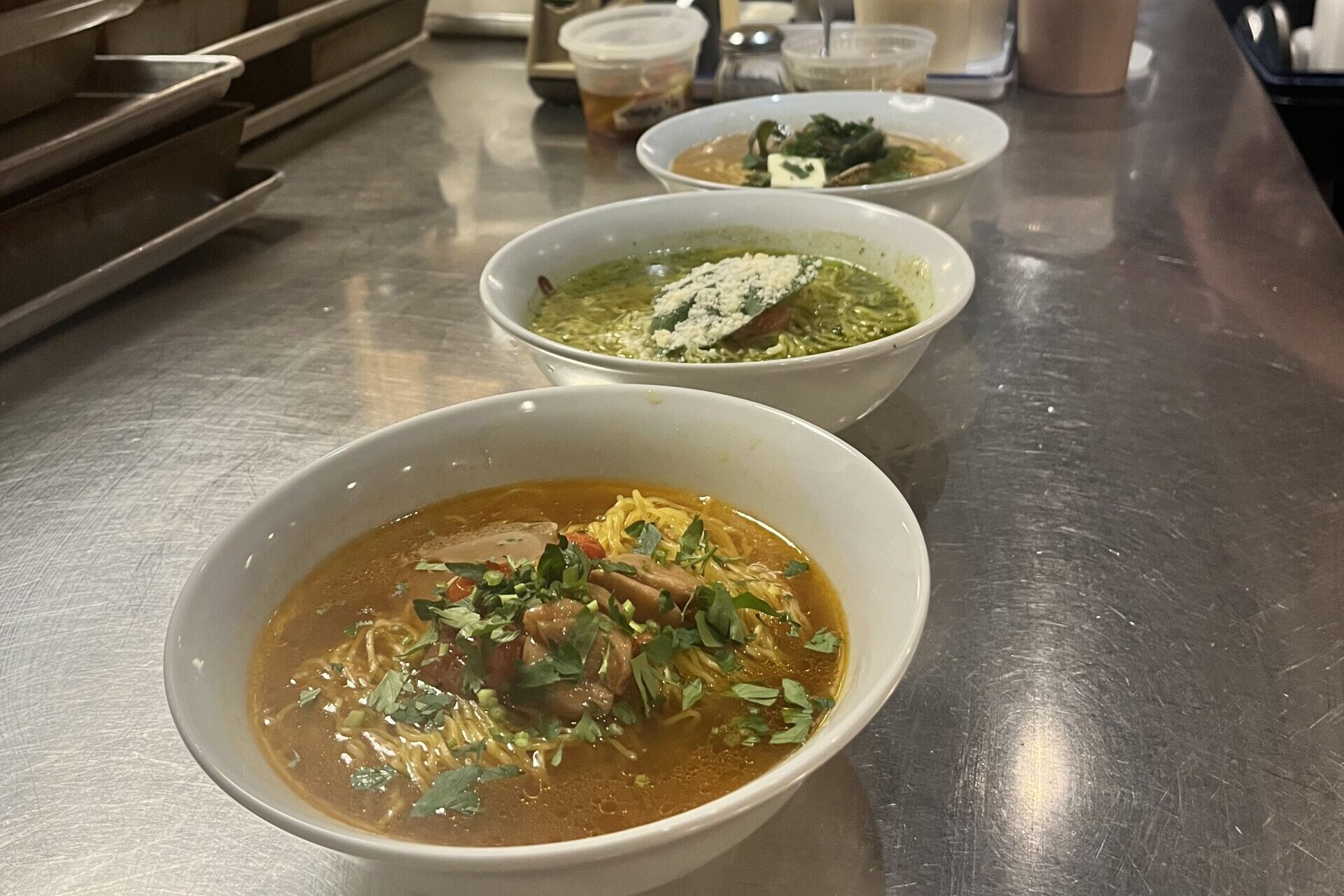This video is no longer available.
Chef Katsuya Fukushima has already redefined fusion food in the District at his Japanese-Italian spot, Tonari. The restaurant’s new brunch menu, offered Saturday and Sunday from 11 a.m. to 3 p.m., goes a step further — completely rethinking ramen and other classic Japanese dishes.
From pesto and clam pasta inspired ramens to sausage and shishito peppers onigiri (nori-wrapped rice balls), Fukushima has flipped around Tonari’s original concept of Japanese flavors and ingredients being used for Italian food.
“So instead of Wafu, which is Japanese-style Italian, now it’s … I don’t know what they call it,” he joked. “So it’s Italian-style Japanese, right? I don’t know if there’s a word for that.”
Fukushima introduced D.C. diners to his original fusion of cuisines with pasta dishes and Detroit-style pizzas with Asian ingredients, like mentaiko, Japanese curry, BBQ eel and miso, after Daikaya Group started renting out a space in Penn Quarter.
“This space was up for lease … so we came and looked at it, and they had this big pizza oven, and we’re like, ‘you can’t get rid of that,’” Fukushima recounted. “It’s just a beautiful piece of equipment. And so we decided — let’s do pizza. And then as soon as we said pizza: ‘Let’s do Wafu.'”
Tonari first opened in 2020, three weeks before COVID-19 shut down the city. Fukushima and his Daikaya Group partners felt that their “honeymoon period,” when hungry residents were “supposed to come in and fall in love” with the restaurant, was cut short.
Fukushima and his team are relighting the spark post-COVID with a new brunch and coffee menu that goes beyond the original pizza concept.
‘High-end ingredients’ sing in the new menu
The Daikaya Group is already known for their ramens, with their namesake restaurant serving locally famous Sapporo-style ramen and Bantam King, just around the corner, focusing on chicken-based ramens.
Fukushima took a completely new approach at Tonari, creating four ramens inspired by simple Italian ingredients. The base of the soups are so simple that three of them are vegetarian, and the fourth just includes seafood.
It might seem odd to take meat out of the equation for ramens, which traditionally include long-simmered bone broths, but the D.C. chef wanted to focus on how both cuisines feature simple ingredients.
“I felt like Japanese and Italian [foods are] very, very similar, because they take on high-end ingredients, or very good ingredients, and that’s the focal point,” he said.

Those quality ingredients are brilliantly put on display in the pesto ramen that has an incredible brightness, with fresh herbs highlighted by a shio tare — also known as a Japanese salt seasoning, composed of lemon, salt and dried kelp.
The arrabbiata ramen captures the spicy, distilled essence of tomatoes and garlic. Japanese seasoning highlights the simplicity of the dish and whole pieces of juicy roasted garlic keep you coming back for another bite.
Miso and clams are already a match made in heaven, but Fukushima throws in butter and white wine that perfectly plays into the vongole ramen’s balance between briny seafood and rich flavors.
Fukushima remembers playing around with the concept of ramen before, offering new special ramens each week during lunch at Daikaya before the pandemic. He reminisces on adding “a parmesan foam espuma on top of a bowl of ramen” and creating a “French onion soup ramen.”
For the onigiri part of the menu, he was stepping into completely new fusion territory. Daikaya offers a version of his grandmother’s onigiri recipe, and while he saw how widely popular onigiri was becoming on social media, Fukushima struggled to connect the rice balls to Italian ingredients at first.
“So then we started taking everything that was in our pantry, and just started making rice balls,” he recalled. “Some of those were disastrous because you can’t put tomato sauce in onigiri.”
He finally hit his stride and worked with his kitchen staff to create five different onigiris that trend from classically Japanese to completely out of left field.

The garlic bread onigiri tastes exactly as you’d imagine, with a combination of olive oil confit garlic, raw garlic and breadcrumbs perfectly emulating the Italian side dish. Together with the warm sticky rice, it creates a decadent comfort food.
His prosciutto onigiri is inspired by the combination of canned tuna and Kewpie mayo, which is also featured on the menu, but takes that classic mix a step further.
“And so instead of the tuna, we ended up chopping up really good prosciutto and adding mayo,” he said. The high-quality prosciutto’s fattiness melds with the mayo, creating a creamy and salty filling.
Fukushima has proven that there are no rules for the traditional Japanese snack, except that you can’t eat the gently formed rice balls with a fork and knife.
“People will eat onigiri, which is supposed to be by hand like a sandwich. They’ll eat it with a fork and knife … like ‘oh my god, what are you doing? You’re destroying my rice,’” Fukushima joked.
Paying ‘homage’ to two different food cultures
Fukushima insists that throwing together foreign ingredients isn’t the most important part of creating successful fusion food.
“When I try to develop a dish, I usually start with either an ingredient or preexisting dish, something that’s been inspiring me, and I end up doing a lot of research,” he said. “I want to familiarize myself with everything about it.”
The chef went to Italy this past year to immerse himself in the food he wants to “pay homage” to on his menu.
“I’m Japanese and American. I feel like I could do the Japanese, the Wafu part of Italian, because I’m very comfortable with the Japanese cuisine part. I’m very comfortable with eating the Italian part,” he joked. “So I don’t force things to happen. I try to respect it [all] ingredient and approach.”
While the Wafu Italian concept has been around in Japan for over 50 years, the idea of combining the two cuisines can be hard to swallow for some American foodies.
“It’s really hard sometimes,” Fukushima said. “Sometimes it’s not Japanese enough, sometimes not Italian enough. But is it delicious?”
While the chef is focused on honing his craft and honoring ingredients, he hopes the incredible flavors and creativity in the new menu will come across to people that love food across the D.C. area.
“That’s the main thing — is making it delicious and making it fun,” he said.
Get breaking news and daily headlines delivered to your email inbox by signing up here.
© 2024 WTOP. All Rights Reserved. This website is not intended for users located within the European Economic Area.








